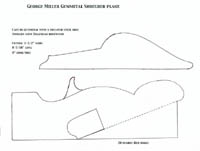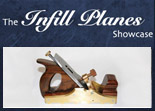Miller “Rhino Horn” Gunmetal Infill Shoulder Plane
 I’ve always found the gentle sweep of a Miller shoulder plane wedge to be one of the most attractive wedges I’ve ever seen. While many of them become “injured” and “deformed” over the years a good quality Miller wedge is always nice to find.
I’ve always found the gentle sweep of a Miller shoulder plane wedge to be one of the most attractive wedges I’ve ever seen. While many of them become “injured” and “deformed” over the years a good quality Miller wedge is always nice to find.
George Miller was almost a relative “latecomer” to the infill plane scene and really only concentrated on one type of infill plane – the shoulder plane. Mind you, what he did he did very well. He is listed as working from 1890 to 1914 at 24 Ampton St, Gray’s Inn Rd in London – quite a considerable period really for a maker of only one style of plane. In most cases that I know of his shoulder planes have been cast from gunmetal, with a thin 1/16″ steel sole “sweated” on with silver solder. The planes I’ve examined from this maker have all been of very high quality and not all of them feature the famous “rhino horn” that Miller is known for. That’s not to say that the shoulder planes without horns started off life this way. Indeed it could be argued that these horns may have become damaged at some stage and were perhaps cut or filed off later on. As there would be absolutely no way to tell for sure that an “unhorned” plane never had a horn in the first place, it’s difficult to say with any certainty that Miller ever made them this way.
While quite a few of the planes that I’ve seen from this maker have been infilled with ebony, this particular George Miller shoulder plane has been infilled with Brazilian rosewood. The 1-1/2″ cutter was bedded at a 20° angle and the gunmetal casting was quite thick and heavy – especially on the base. The rosewood used is quite wild and figured and it would have been interesting to see the rest of the log that this piece had come from.
The mouth is nice and tight – not too easy to achieve with a casting, but made much easier when you can sweat on a steel sole. The chamfering along the top edge is slight with basically just the “sharpness” taken off. As I find with all George Miller shoulder planes the comfort and fit in the hand is superb and it is definitely a style which I like a lot. It is a very heavy hand plane to wield for a long time though so it’s just as well that it’s generally not used for long periods at any one time. Having a heavy mass to it is a rather big bonus when it comes to cleaning up shoulders however!
Although this particular plane is cast in gunmetal, it would be a simple enough project to make a version of it by dovetailing the plates together – or even just riveting the two sides to a center “block” if dovetailing seems too daunting. Whether made in bronze, brass or steel it’s sure to look good, as well as being quite handy around the workshop.
To download a JPEG or PDF file for this hand plane (or both of them together in a ZIP file), please click one of the links below.
Download George Miller Infill Shoulder Plane (JPEG)Download George Miller Infill Shoulder Plane (PDF)Download George Miller Infill Shoulder Plane (ZIP)






